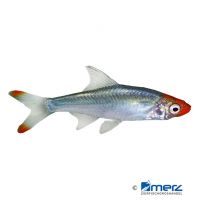Burmese Rammy Nose (Sawbwa resplendens)
| Burmese Rammy Nose Sawbwa resplendens | |
|---|---|
| Name | Burmese Rammy Nose |
| Name Lat. | Sawbwa resplendens |
| Family | Carps |
| Family lat. | Cyprinidae |
| Order | Carps |
| Order lat. | Cypriniformes |
| Origin | South Asia |
| Habitat | Myanmar, Lake Inle |
| Diet | Omnivore |
| pH | 6.0-8.0 |
| Behavior | Peaceful |
| Keeping | Swarm |
| Care Level | Moderate |
| Reproduction | Substrate spawner |
| Breeding | Difficult |
| Life Span | 3-5 years |
| Protection | No |
| Metric Units | |
| Size | 2-3 cm |
| Temperature | 20-24 °C |
| Hardness | 8-15 °dH |
| Aquarium | 60 l |
| US Units | |
| Size | 0.8"-1.2" |
| Temperature | 68-75 °F |
| Hardness | 142-267 ppm |
| Aquarium | 15 gal |
Distribution and habitat
The nudibranchs are native to Myanmar, where they are found exclusively (endemically) in Inle Lake and the surrounding swamps, which are located at an altitude of approx. 900 m and are only 2-3.7 m deep. They live there in shoals in the clear water at the grass and reed covered edges of the lake.
Maintenance
The aquarium should have dense perimeter planting reaching the water surface, with plenty of hiding and retreat opportunities (roots, stones) and provide adequate swimming space
A dark, round gravel or sand substrate, shaded light (floating plants) and a weak current is ideal. In harder, slightly alkaline water they show the most beautiful coloration.
No ammonia, ammonium and nitrite should be detectable in the water, the nitrate value should not exceed 100 mg/l. To ensure the water quality and oxygen content, a filter and heater adapted to the aquarium size is required, as well as lighting for the species-appropriate day-night rhythm of the animals.
Diet
In nature they feed on insect larvae, small crustaceans, worms and zooplankton. The food supply consists of live food, such as daphnia, cyclops, artemia, mysis and mosquito larvae, which are also well accepted frozen, plus commercially available frozen special food mixtures, supplemented with a high-quality, protein-rich dry food (granules, flakes, micropellets).
Regular and varied feeding promotes health and prevents deficiency symptoms. Only as much should be fed as is eaten in a few minutes.
Behaviour and compatibility
They are lively and very peaceful schooling fish, well suited for a community tank with other small and peaceful fish. A group of at least 8 animals should always be kept together, but preferably more.
Basically, only compatible fish species with similar demands on water conditions and water temperature should be socialized.
Sex dimorphism
Males are steel blue in color, with red tail fin tips and head. The somewhat smaller females are inconspicuously olive or brownish in color and appear more rounded.
Reproduction and breeding
The female usually spawns on fine-feathered plant leaves near the water surface. The larvae hatch after 3 to 4 days and swim freely after a total of 5 to 6 days.
Fry must be fed several times a day with special rearing food (infusoria, Artemia nauplii, dust food). In a community tank breeding is hardly possible, because the spawn is easy prey.
Important
Giving the name to the naked bower is its scaleless body.
These very shy fish should not be kept in water that is too warm. At higher temperatures and too soft water they do not feel well, are susceptible to disease and their colors can fade.
The well-being of the fish should be checked regularly. Temperature should be checked daily, pH, hardness and nitrate levels at least every 14 days. Regular partial water changes are recommended, even if the contaminant level has not yet reached the upper limit. Sudden changes in water quality should be avoided. Newly introduced fish must be accustomed slowly to the water in the aquarium.
Further literature can be found in your pet store.
References
Text: Werner Winter; Image: Merz Zierfischgroßhandel
Source: BMELV (1998): Tierschutzgutachten - Haltung von Zierfischen (Süßwasser); BAENSCH & RIEHL (2006): Aquarien Atlas Bd. 2, Mergus Verlag; ENGELMANN (2005): Zootierhaltung - Tiere in menschlicher Obhut: Fische, Verlag Harri Deutsch
- Gemäß § 21 Abs. 5 Tierschutzgesetz idgF
